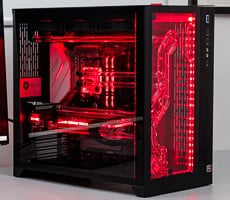Eurocom M98NU XCaliber Gaming Notebook Review
We began our testing with SiSoftware's SANDRA 2009 SP4, the System ANalyzer, Diagnostic and Reporting Assistant. We ran four of the built-in subsystem tests that partially comprise the SANDRA 2009 SP4 suite: Processor Arithmetic, Multimedia, Memory Bandwidth, and Cache and Memory.
|
|
|
||||
|
Processor Arithmetic |
|
Multimedia |
Memory Bandwidth |
Cache and Memory |
As expected, the M98NU XCaliber puts in a very strong showing on all the SiSoftware's SANDRA tests. Of the comparison systems that SANDRA automatically generates, only the 2.0GHz Core i7 920XM has notably faster performance than the M98NU XCaliber's 2.53GHz Core 2 Extreme QX9300 on the Processor Arithmetic test. On the Processor Multi-Media test, the M98NU XCaliber is actually a bit speedier than the Core i7 920XM processor--this is likely due to the QX9300's greater total amount of on-die cache. On the Cache and Memory test, the M98NU XCaliber is leaps and bounds ahead of all the comparison systems--but considering that all the comparisons are notably lower-end dual or single-core processors, it's not really a fair comparison. On the Memory Bandwidth test, the M98NU XCaliber falls behind the ATI Xpress 1250 chipset--which is curious as the 1250 is intended for lower-end, low-power systems and devices (also, there aren't many 1250-based notebooks available to begin with).
|
|
|
Next up we ran the M98NU XCaliber through Futuremark's PCMark Vantage system performance metric. PCMark Vantage runs through a host of different usage scenarios to simulate different types of workloads including High Definition TV and movie playback and manipulation, gaming, image editing and manipulation, music compression, communications, and productivity. Most of the tests are multi-threaded (up to three simultaneous threads), so the tests can exploit the additional resources offered by a multi-core processor.

We ran into a strange issue with PCMark Vantage on the M98NU XCaliber. It ran fine when SLI was disabled; but when we enabled SLI, it would either provide significantly lower scores or not provide a score at all because the test failed. We even tried updating the graphics driver; but that did not solve the problem. So the scores you see above are from the benchmark running on the notebook with SLI disabled. If the benchmark was working properly on the system with SLI enabled, you would likely see a higher Gaming score--and, subsequently, an even higher PCMark score.
Regardless, the M98NU XCaliber performs very well on this test suite--even without SLI enabled. In fact, the M98NU XCaliber even outperforms the Alienware M17x, which uses the same 2.53GHz Core 2 Extreme QX9300 processor. The 2.8GHz Core 2 Duo X9000-based Dell XPS M1730 does a bit better than the M98NU XCaliber--but mostly because it gets a much higher Gaming score as a result of its dual Nvidia GeForce 9800M GTX GPUs running in SLI mode. Had we gotten the test to work properly with the M98NU XCaliber's SLI mode, its Gaming and overall PCMark score might very well be higher than the that of the M1730.










